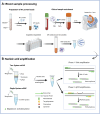Rapid and sensitive identification of Candida in blood based on M1 beads enrichment combined with multiple recombinase-aided PCR: a culture-independent approach
- PMID: 40182772
- PMCID: PMC11966459
- DOI: 10.3389/fcimb.2025.1552529
Rapid and sensitive identification of Candida in blood based on M1 beads enrichment combined with multiple recombinase-aided PCR: a culture-independent approach
Abstract
Introduction: Clinically, timely diagnosis and effective treatment of Candida bloodstream infections rely on rapid and sensitive detection methods. However, the long turn-around time and low detection rate of blood culture (the gold standard) make rapid diagnosis of Candida challenging. This study develops a novel molecular assay (M1-mRAP) designed for the rapid and sensitive detection of three Candida species in blood samples: Candida albicans(CA), Candida tropicalis(CT), and Candida glabrata(CG).
Methods: We used the M1-mRAP method aimed at detecting Candida DNA in blood samples, in which we developed a novel multiplex recombinase-aided PCR (mRAP) assay for sensitive amplification of Candida DNA and used a self-developed recombinant human mannan-binding lectin beads (M1 beads)method for enrichment of Candida in blood. The analytical sensitivity of mRAP was evaluated using Candida recombinant plasmids. The analytical sensitivity of the M1-mRAP method for blood sample detection was assessed using quantitative Candida simulated blood samples. The clinical performance of the mRAP and M1-mRAP methods was evaluated in 120 non-blood samples and 9 blood samples and compared with conventional qPCR methods.
Results: The limit of detection(LOD) for CA, CT, and CG by the mRAP method were 4, 4, and 3 copies/μL, respectively. The LOD for CA, CT, and CG simulated blood samples by the M1-mRAP were 2, 2, and 1 CFU/mL, and the overall detection time was about 3.5 h. Clinical assays of mRAP and M1-mRAP showed that these two methods were consistent with qPCR (P<0.05), but had better clinical detection ability than qPCR. Specifically, the mRAP method identified 5 (4.2%) qPCR-negative samples, while M1-mRAP detected 1 (11.1%) classified as the qPCR grey zone sample.
Conclusion: The M1-mRAP method provides rapid and sensitive detection of low concentrations of CA, CT, and CG blood samples and has the potential to emerge as an important tool for the early detection of Candida bloodstream infections in clinical settings.
Keywords: Candida; bloodstream infection; multiple detection; recombinant human mannan-binding lectin protein beads (M1 beads); recombinase-aided PCR assay(RAP).
Copyright © 2025 Wang, Chen, Peng, Tie, Gao, Han, Lyu, Li, Zhang, Gao, Shen, Ma and Feng.
Conflict of interest statement
The authors declare that the research was conducted in the absence of any commercial or financial relationships that could be construed as a potential conflict of interest.
Figures




Similar articles
-
Dual one-step recombinase-aided PCR for rapid detection of Candida in blood.Appl Microbiol Biotechnol. 2025 Mar 22;109(1):70. doi: 10.1007/s00253-025-13452-y. Appl Microbiol Biotechnol. 2025. PMID: 40119195 Free PMC article.
-
Establishment of a Multiplex Detection Method for Common Bacteria in Blood Based on Human Mannan-Binding Lectin Protein-Conjugated Magnetic Bead Enrichment Combined with Recombinase-Aided PCR Technology.Biomed Environ Sci. 2024 Apr 20;37(4):387-398. doi: 10.3967/bes2024.043. Biomed Environ Sci. 2024. PMID: 38727161
-
Multi-probe real-time PCR identification of four common Candida species in blood culture broth.Mycopathologia. 2014 Jun;177(5-6):251-61. doi: 10.1007/s11046-014-9743-7. Epub 2014 Apr 17. Mycopathologia. 2014. PMID: 24740169
-
PCR-enzyme immunoassay of rDNA in the diagnosis of candidemia and comparison with amplicon detection by agarose gel electrophoresis.Int J Med Microbiol. 2004 Jul;294(1):45-51. doi: 10.1016/j.ijmm.2004.01.002. Int J Med Microbiol. 2004. PMID: 15293453
-
Molecular microbiological methods in the diagnosis of neonatal sepsis.Expert Rev Anti Infect Ther. 2010 Sep;8(9):1037-48. doi: 10.1586/eri.10.89. Expert Rev Anti Infect Ther. 2010. PMID: 20818947 Free PMC article. Review.
References
-
- Camp I., Füszl A., Selitsch B., Kröckel I., Kovac K., Wahrmann M., et al. . (2024). Is the T2MR Candida Panel a suitable alternative to the SeptiFast for the rapid diagnosis of candidemia in routine clinical practice? Clin. Microbiol. Infect. 30, 816–821. doi: 10.1016/j.cmi.2024.02.024 - DOI - PubMed
-
- Chen X. L., Zheng H., Li W. G., Zhong Y. H., Chen X. P., Lu J. X. (2020). Direct blood culturing of Candida spp. on solid medium by a rapid enrichment method with magnetic beads coated with recombinant human mannan-binding lectin. J. Clin. Microbiol. 58. doi: 10.1128/jcm.00057-20 - DOI - PMC - PubMed
Publication types
MeSH terms
Substances
LinkOut - more resources
Full Text Sources
Medical
Molecular Biology Databases

